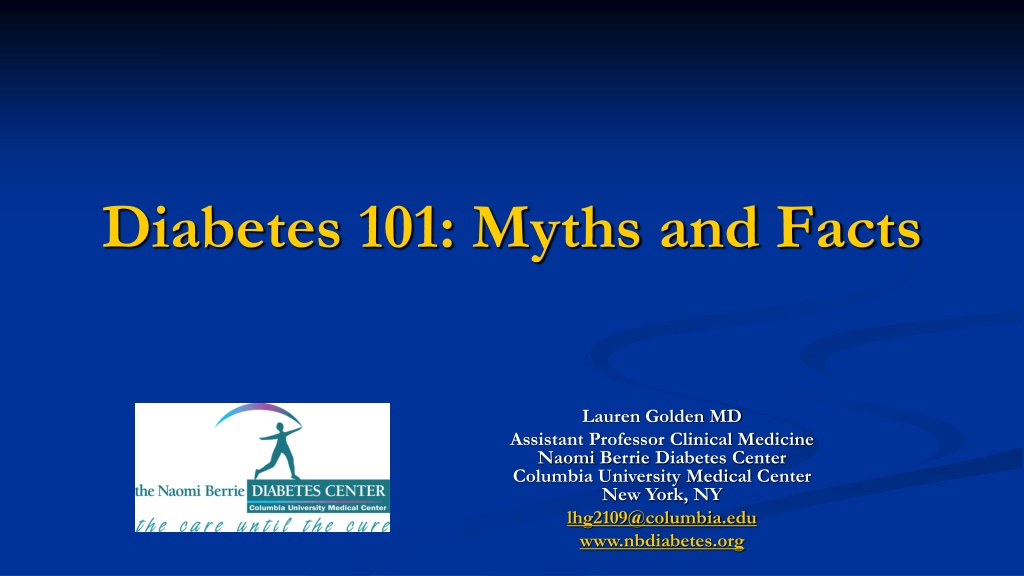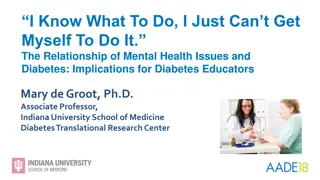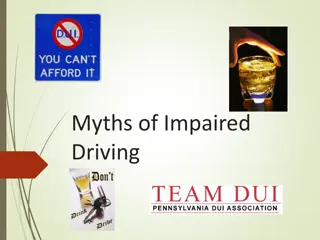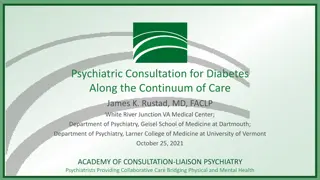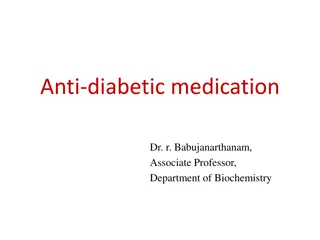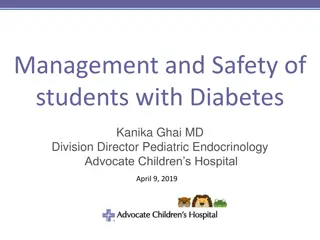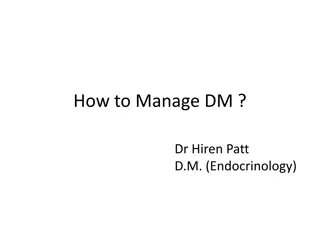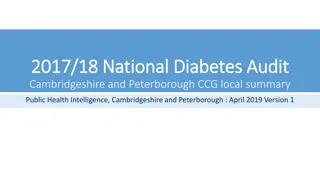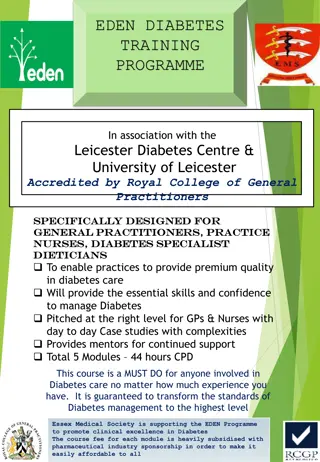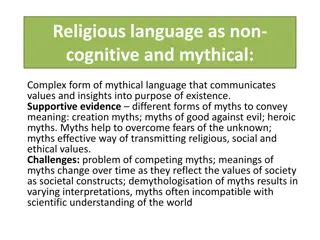Debunking Common Myths About Diabetes
Diabetes can't be solely attributed to sugar consumption. Genetics and insulin resistance play significant roles. Understanding the criteria for diagnosing diabetes, pre-diabetes, and the importance of the Hemoglobin A1C test are crucial in managing the condition. This article sheds light on prevalent myths and facts surrounding diabetes, emphasizing the factors contributing to Type 2 diabetes development.
Download Presentation

Please find below an Image/Link to download the presentation.
The content on the website is provided AS IS for your information and personal use only. It may not be sold, licensed, or shared on other websites without obtaining consent from the author.If you encounter any issues during the download, it is possible that the publisher has removed the file from their server.
You are allowed to download the files provided on this website for personal or commercial use, subject to the condition that they are used lawfully. All files are the property of their respective owners.
The content on the website is provided AS IS for your information and personal use only. It may not be sold, licensed, or shared on other websites without obtaining consent from the author.
E N D
Presentation Transcript
Diabetes 101: Myths and Facts Lauren Golden MD Assistant Professor Clinical Medicine Naomi Berrie Diabetes Center Columbia University Medical Center New York, NY lhg2109@columbia.edu www.nbdiabetes.org
How Do We Diagnose Diabetes?
Criteria For Diagnosis of Diabetes Fasting blood sugar >126 >126 mg/dL 2 Hour blood sugar >200 tolerance test >200 mg/dL after a glucose Random blood sugar >200 >200 mg/dL + symptoms HbA1c HbA1c 6.5% 6.5%, confirmed ADA. V. Diabetes Care. Diabetes Care 2013;36(suppl 1):S17.
Criteria for Diagnosis: Pre-Diabetes Fastingblood sugar100-125 mg/dL 2 Hourblood sugar 140-199 mg/dL HbA1c HbA1c5.7-6.4% ADA. V. Diabetes Care. Diabetes Care 2013;36(suppl 1):S17.
What is Hemoglobin A1C? Hemoglobin A1C is a test that measures a person's average blood sugar level over the past 3 months. Hemoglobin is the part of a red blood cell that carries oxygen to the cells. When blood sugars are high, hemoglobin joins with the sugar in the bloodstream. The A1C test measures the percentage of the red blood cell has sugar attached to its hemoglobin. The higher the percentage, the higher your blood sugars have been over the past 3 months. Hemoglobin with sugar attached (glycated) Normal Hemoglobin
Myth #1: Diabetes is caused by eating too much sugar Fact: Type 2 diabetes is caused by an inability of the pancreas to make enough insulin or if there is a problem with how the insulin is used by the cells. It is NOT from eating too much sugar. However, a more balanced diet can help to manage blood sugars. So, if diabetes is not caused by eating to much sugar, why do some people get diabetes?
Who Gets Type 2 Diabetes? People inherit genes that contribute to insulin resistance in liver, muscle and fat This means that insulin does not work as effectively in these tissues and sugar cannot get as easily into cells Beta cells, the cells that produce insulin, initially compensate by increasing insulin production to overcome the resistance Overtime, beta cells fail, insulin levels fall, blood sugars rise, and people are diagnosed with diabetes
Risk Factors for Type 2 Diabetes Age Ethnic background (African American, Latino, Native American, Asian American, Pacific Islander) Family members with diabetes: mother, father, sister, brother Previous diagnosis of gestational diabetes (diabetes during pregnancy) Weight status: overweight and obesity Physical Activity Status Those with pre-diabetes
Age-adjusted Prevalence of Obesity and Diagnosed Diabetes Among US Adults Obesity (BMI 30 kg/m2) 1994 2000 2015 No Data <14.0% 14.0% 17.9% 18.0% 21.9% 22.0% 25.9% > 26.0% Diabetes 1994 2000 2015 No Data <4.5% 4.5% 5.9% 6.0% 7.4% 7.5% 8.9% >9.0% CDC s Division of Diabetes Translation. United States Surveillance System available at http://www.cdc.gov/diabetes/data
Myth #2: If you are at risk for diabetes, there is nothing you can do to prevent it Fact: healthy lifestyle changes, including diet and exercise, can delay the onset of diabetes in those at risk This includes people with pre-diabetes
Exercise and Weight Loss Can Reduce the Risk of Developing Type 2 Diabetes 5-10% weight loss reduces development of diabetes by 58% in subjects with IGT and Improves Control in Those with Diabetes Diabetes Prevention Program Research Group, . N Engl J Med 2002;346:393-403
Myth #3: If you have diabetes, you cannot eat any carbohydrates ever again Fact: People with diabetes typically should be eating the same diet as anyone else high in vegetables, fruits, fiber, whole grain, lean meats, and heart healthy fats. Moderate in sodium and low in saturated fat. The key is to have small portions and to choose complex carbohydrates when eaten with meals Try to save more processed carbohydrates (baked goods etc) for special occasions so the focus can be on balanced meals most of the time.
If you have diabetes, is it better to check blood sugars fasting or after eating? Your provider may ask you to start by checking an occasional fasting blood sugar at home using a glucose meter This shows how you body is doing when you have not eaten for many hours A normal fasting blood sugar is <100mg/dL Acceptable for diabetes is <135mg/dL, and as close to 100mg/dL as possible
When would I check a blood sugar after eating? Sometimes you may want to see the effect of certain foods on your blood sugar For example, a starchy meal would be expected to raise your blood sugar By two hours after eating, a normal blood sugar would be <140mg/dL Acceptable for diabetes is up to 150-180mg/dL If your blood sugar is higher than that, your body had difficulty handling the food you ate for that meal
Myth #4: It is inevitable that you will have to take insulin for diabetes, and this means that you have failed to take care of your diabetes properly Fact: Diabetes changes over time. Some people, particularly early in the course of their diabetes, may be able to manage their diabetes by eating more balanced meals and increasing their activity levels. Over time (generally 5-10 years), many people with diabetes will require some sort of medication by mouth. As time goes on (generally >10 years or more since diagnosis), and the body s insulin production declines, many people will eventually require insulin.
Classes of Diabetes Medications How they work Decreases sugar production by the liver, increases the body s sensitivity to insulin Help stimulate insulin production in response to a meal, help decrease sugar production by the liver Help stimulate insulin production in response to a meal, help decrease sugar production by the liver, reduce appetite Allow the kidneys to get rid of sugar in the urine canagliflozin, dapagliflozin, Examples Biguanides metformin DPP-4 Inhibitors sitagliptin, saxagliptin, alogliptin, linagliptin GLP-1 Mimetics exenatide, liraglutide, albiglutide, dulaglutide SGLT-2 Inhibitors empagliflozin Pioglitazone, rosiglitazone Thiazolidenediones Increase the body s sensitivity to insulin Sulfonylurea glipizide, glimepiride, glipizide ER, glyburide repaglinide, nateglidnide Stimulates insulin production by the pancreas Meglitinides Stimulates insulin production by the pancreas Insulin detemir, glargine, degludec, humulin, lispro, aspart, glulisine, regular Increases the body s insulin levels to overcome resistance or replace deficiency
Myth #5: The way my provider decides what medication to prescribe me is totally random. Fact: If diet and exercise are not enough, your provider may recommend medical therapy for your diabetes, based on national guidelines and individual characteristics. metformin is the preferred initial drug for treatment of type 2 diabetes, as long as there are no medical reasons why you should not take it If a second drug is needed to control the blood sugars, the decision about what drug to add next depends on the presence or absence of heart disease Diabetes Care 2018 Jan; 41 (Supplement 1): S1-S159
Medical Management of Type 2 Diabetes In patients with type 2 diabetes and atherosclerotic heart disease, the provider should next consider adding a diabetes medication that also reduces cardiovascular events and death from cardiovascular disease (empagliflozin and liraglutide; consider canagliflozin) In patients without atherosclerotic heart disease, the provider should consider the importance of weight loss/weight gain, the risk of low blood sugars, oral vs injectable therapy, and the side effect profile of individual drugs. Diabetes Care 2018 Jan; 41 (Supplement 1): S1-S159
